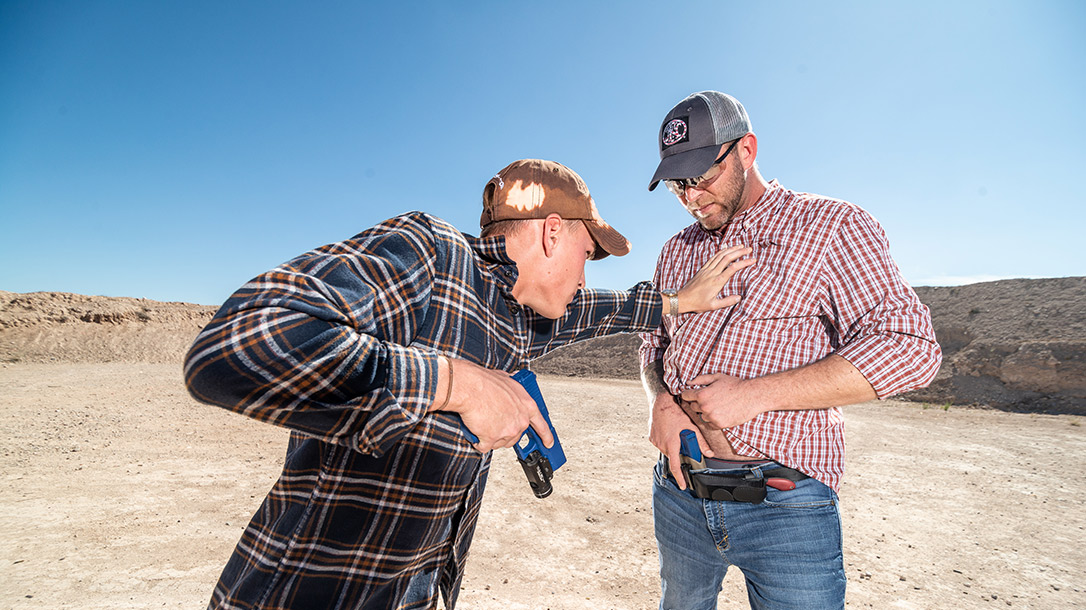One harsh reality of armed combat is that a great deal of it takes place at very close quarters. While there’s no central data bank regarding armed citizens, we may get some perspective by looking at the police experience. Close quarters self-defense is something law enforcement deals with regularly.
Close Quarters Self-Defense and Law Enforcement
For many years, a number of groups have tracked police action shootings. The information collected tells us that most of these events take place at relatively short range. Just over 90 percent occur at distances closer than 7 yards. About half the time the assailant has invaded personal space and is close enough to reach out and touch.
Exactly what implications might this have for the armed citizen? First, consider that the police have a very different role, which includes interdicting violent crime. In many instances, they may have some forewarning of danger and can take the appropriate measures to gain a tactical advantage before approaching a potentially violent subject.
Advertisement — Continue Reading Below
Policing remains an intimate business, and officers often have to get close to people to conduct seemingly routine business such as a credential check or rendering first aid. Even when there is no apparent threat, matters can spin out of control in seconds. In recent years, there has been a serious spike in unprovoked attacks on law enforcement officers. Many occur at extremely close quarters.
Self-Defense and Private Citizens
On the other hand, in incidents where private citizens had to use deadly force, it was because they were targeted as victims of violent crime and had no alternative. Examples include muggings, robberies, carjacking attempts and sexual assaults.
Criminals will often use tricks to get inside your personal space to put you off guard. As an example, they may ask for directions or a light. The best advice I can give is to reply “I don’t smoke,” and quickly move on. Unfortunately, there is absolutely no guarantee that an assailant will not still enter your personal space and attack.
Advertisement — Continue Reading Below
The problem with attacks at extreme close quarters is that, for most of us, this is the fight we have not trained for. You might indeed be a crackerjack shot and be armed with a state-of-the-art pistol. But assuming deadly force is justified, how effective do you think you might be drawing and firing after being sucker-punched in the face, if the assailant now has placed you in a bear hug? Before you resort to your higher power, you must first solve your immediate problem, which is to buy yourself a little bit of time and distance.
Interrupting
When you’re in contact with an assailant, it may be impossible to immediately go to the gun. In fact, bringing out the gun too soon may put you in a position where the gun’s barrel could easily be deflected or you could be disarmed.
The first order of business is to change the focus of your attacker so you can better assess the situation and consider your next step. In extreme close quarters, the formula for turning the tables on an assailant includes interrupting their breathing, vision and/or balance.
Advertisement — Continue Reading Below
Because your assailant has closed the gap and invaded your personal space, he has violated the 3-foot rule. This makes your task easier. One thing he probably doesn’t expect is a sudden, violent counterattack.
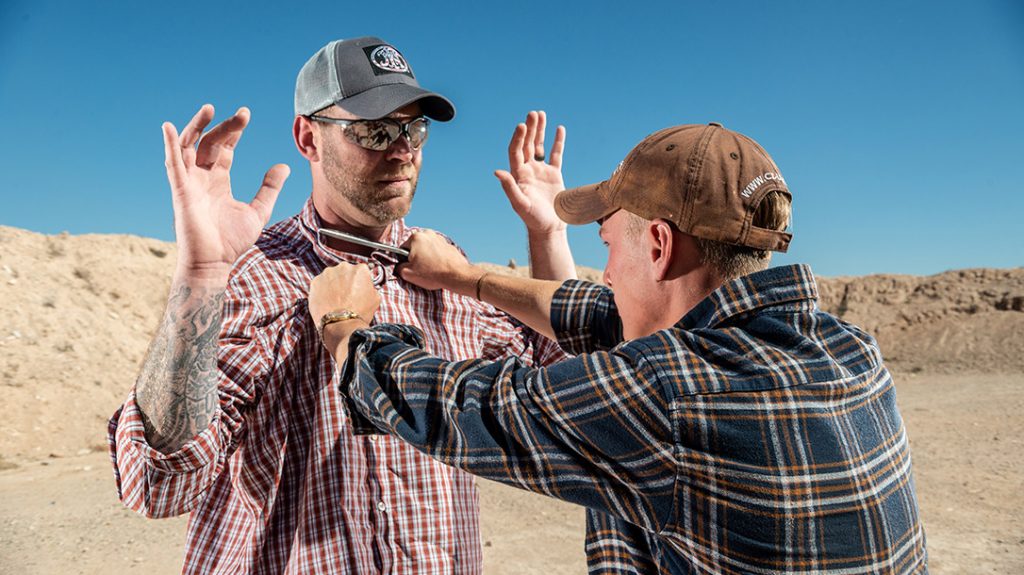
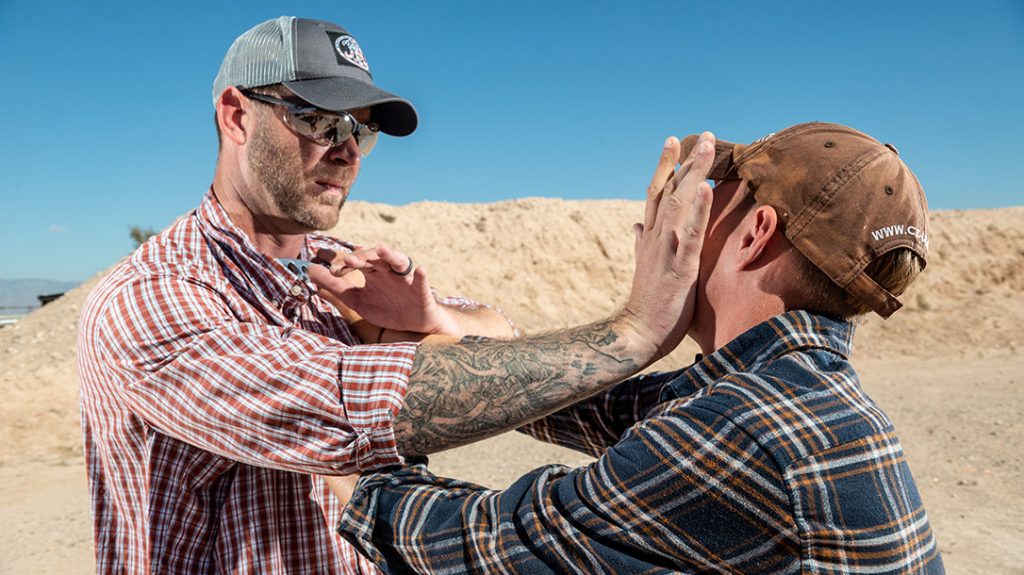
Advertisement — Continue Reading Below
Pinned to a Wall
For example, say he has grabbed your jacket and pushed you up against a wall. If this is a robbery attempt, it’s very likely he will be running his mouth and making all sorts of demands. This is a good thing because talking will slow down his reaction time.
Your hands may be up in an act of feigned submission, and once he starts talking again, deliver a hard palm strike to the upper lip and nose and allow your fingers to go the eyes. This will probably get his attention. Immediately follow up with a knee thrust or leg sweep, which will disrupt his balance. This will allow you to create distance and assess the situation.
Does my assailant have a weapon or are they attempting to access a weapon of some sort? Not every assault will justify the use of deadly force. Is there a second potential assailant in close proximity? Can I escape?
Advertisement — Continue Reading Below
Armed assailants will sometimes close inside your personal space in order to intimidate you. Again, someone menacing you with a gun inside your personal space is violating the 3-foot rule and is setting himself up for a disarm and defeat.
Should he press that handgun up against your head or chest, you have now located it, which makes your job easier. With a bit of practice, you can quickly deflect the muzzle of your adversary’s gun and take it from him before he can react.
Close-Quarters
Most training institutions and instructors teach some form of extreme close-quarters shooting. However, many don’t think it through and fail to consider violent physical contact between the good guy and the assailant.
Advertisement — Continue Reading Below
Some of the more popular extreme close-quarters shooting methodologies include firing from the retention position, shove and shoot and driving forward. No one technique is best for every conceivable situation. Considerations include the environment you’re in, the type of weapon and whether the subject actually has that weapon in hand.
In the retention position, the handgun is held close to the body with the strong-side elbow extended to the rear. The support hand is brought up high to protect the head, neck and upper chest. It’s important to retract the elbow as far as possible to the rear, keeping the handgun close to the body. With a semi-automatic pistol, a slight cant to the outside will prevent the slide from coming in contact with the body or clothing and causing a stoppage.
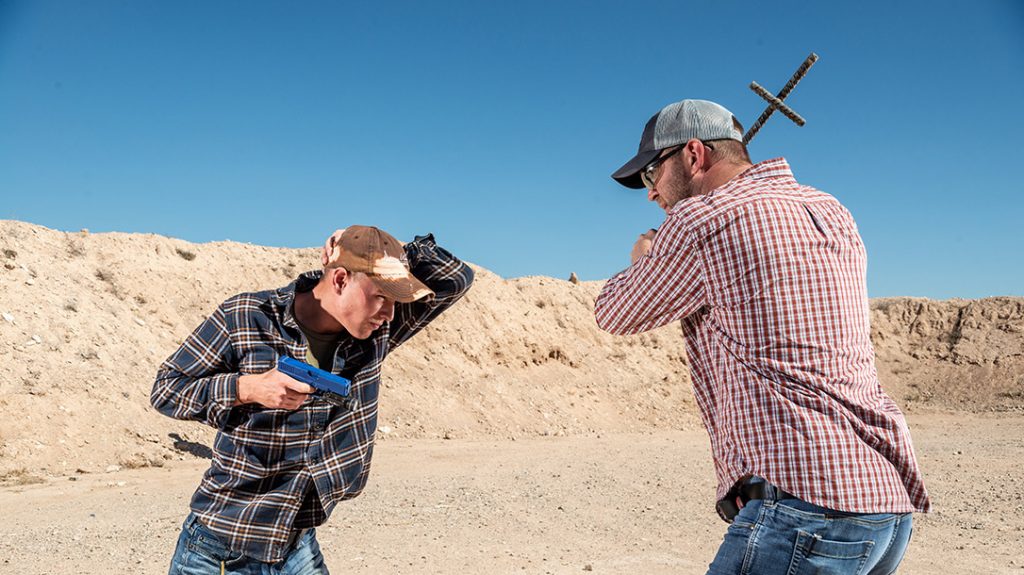
Advertisement — Continue Reading Below
Shove and Shoot
Shove and shoot means exactly what the name implies. Once you have made a decision to fire, push off your adversary hard to create distance, move to the rear, draw to eye level and fire. I would suggest moving rearward at an oblique angle. If you experience a hang up on the draw, keep moving until you clear leather.
Some trainers advocate striking the face for the shove. But to me it’s simply too easy for my adversary to quickly move his head. I’ll stick with a one- or two-hand thrust to the body.
Driving forward is yet another remedy. With this technique, one drives forward in an aggressive manner, while drawing the handgun. The support hand palm comes up in contact with the subject’s chin, disrupting his balance. The gun is held close to the body much as in the retention position, and the muzzle is angled down to avoid covering your own body with the gun.
Advertisement — Continue Reading Below
Techniques are situationally dependent. You probably wouldn’t want to use shove and shoot on a narrow subway platform or dock where a miscue in movement would be problematic. Driving forward wouldn’t be a good choice against an assailant holding a knife in front of his body. Get cozy with all three techniques and choose wisely.
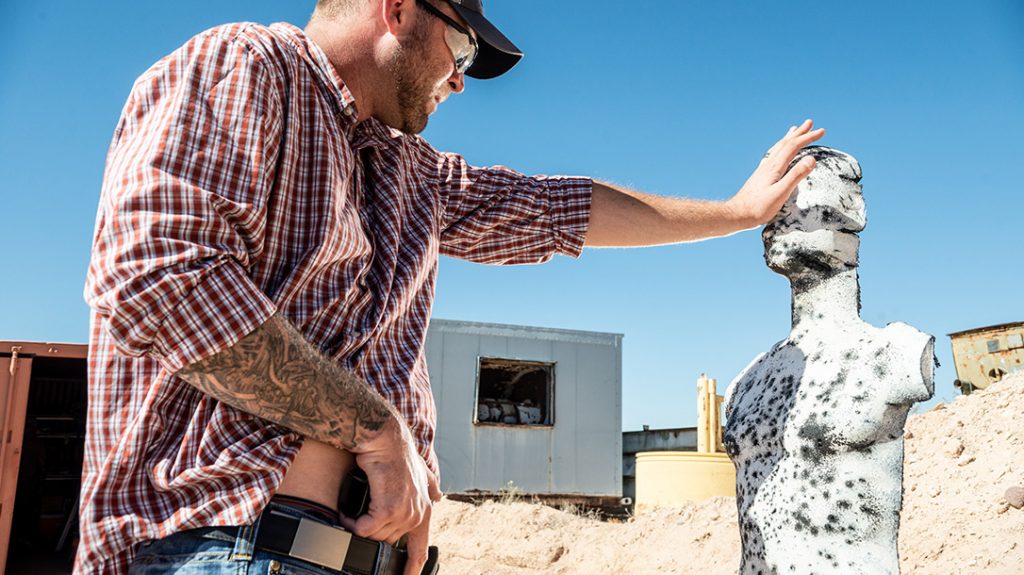
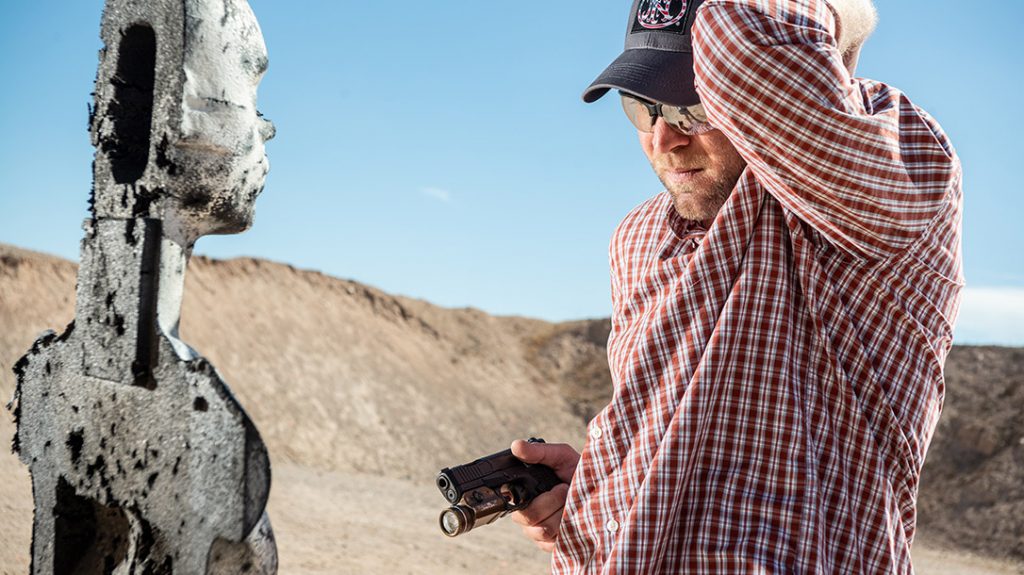
Contact Shots
It is a real possibility in extreme close quarters self-defense to have the muzzle of your firearm pressed up against the body of the assailant. Again, the assumption is that deadly force is justified to protect your life. In this particular instance, you have been pushed up against a vehicle, and the assailant is attempting to bring a brick into play. Contact with the assailant’s body has pushed your slide out of battery and rendered your pistol a non-shooter.
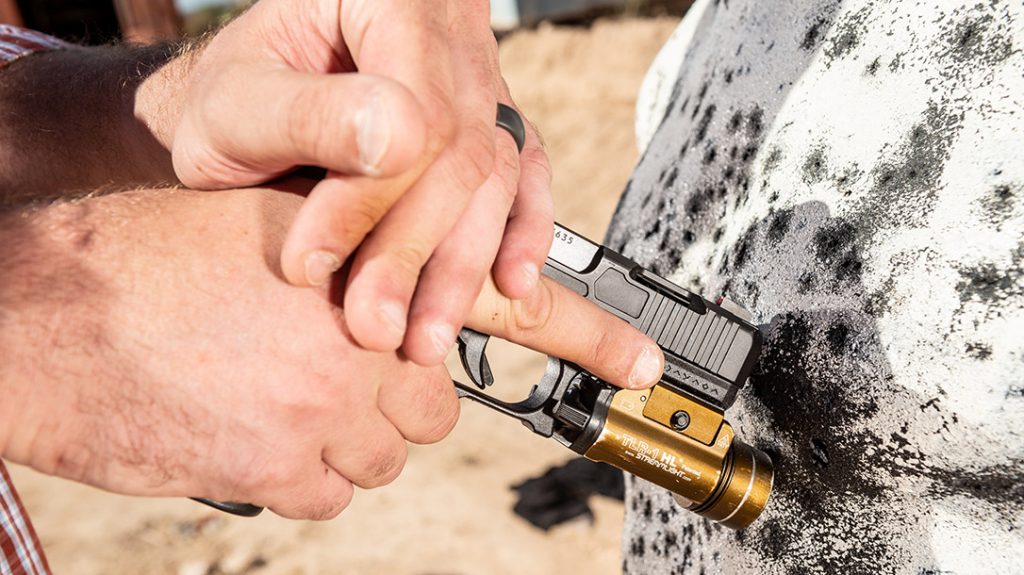
Can you drive him back? In this particular instance, your assailant outweighs you by 100 pounds and there is just no moving him off. If by chance you can get your support hand on the gun and wrap it around the slide, you might have a fix. Pull back a tad with the strong-side shoulder, and more than likely your pistol will go back into battery.
Pressing the trigger will cause the gun to fire, which hopefully changes the assailant’s focus, allowing you to move. Your pistol, however, will have experienced a stoppage, which you must clear before you can fire additional shots.
Others have already noted this, but when firing within personal space, a revolver might actually be a better tool than a semi-auto. With the revolver, contact shots or interference from clothing are not issues.
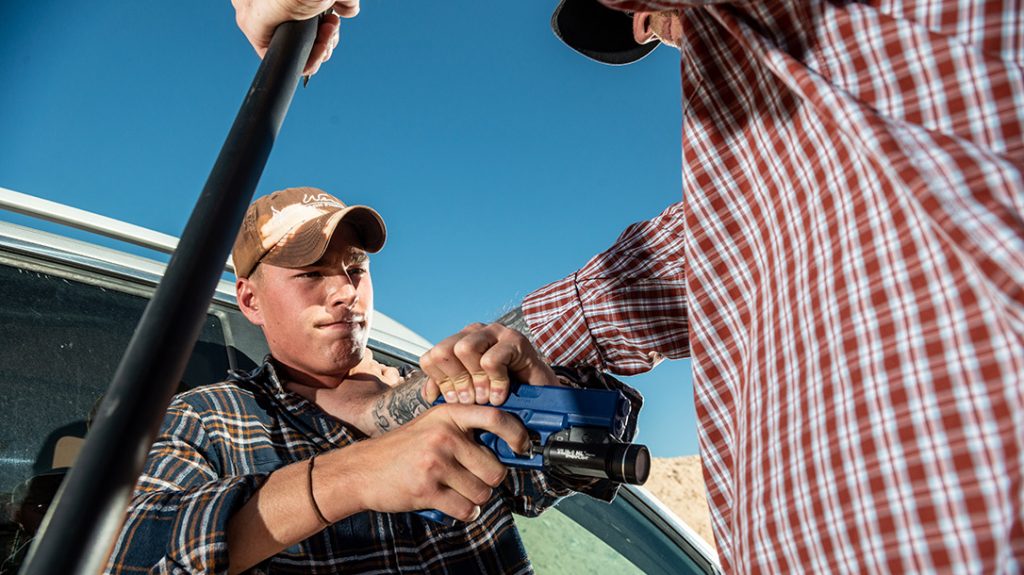
Training For The Worst
Preparing for an armed encounter inside of conversational distance requires a little outside-the-box thinking. In traditional training, empty-hand skills and firearms were separate entities and there was no integration between the two.
I am of the opinion that harm befalls both private citizens and cops because their empty-hand skills are lacking. And the fact that they are armed doesn’t factor into the equation once their adversary has gained the upper hand. In reality, we have to be force generalists. A few simple empty-hand techniques can save the day, and one does not have to be a true martial artist to make them work.
When teaching extreme close quarters shooting, I have my students stand in front of that two-dimensional paper target and deliver a series of simulated finger thrusts, palm strikes, hammer fists and knee thrusts. On the command to fire, they disengage and shoot.
I also create a “bad guy” by taping a dozen or so cardboard silhouettes together and adding a T-shirt along with a pair of jeans and a mask. When mounted on a stand, this setup affords the opportunity to practice contact shots.
Inert trainers and Airsoft guns will also give you some additional perspective on extreme close quarters shooting. If you have some protective gear, suit up, for an added touch of realism. Have a buddy act as an aggressor, and you will quickly find this isn’t quite what you expected.
Your choreography may not be pretty, but in the end, form doesn’t matter—only results.
